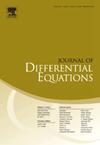微管驱动胶质瘤侵袭模型的行波解决方案
IF 2.3
2区 数学
Q1 MATHEMATICS
引用次数: 0
摘要
本文建立了表征胶质瘤细胞侵袭的非合作反应扩散模型行波解的存在性。该模型描述了神经胶质瘤的微管驱动迁移,包括描述肿瘤体积动力学的ODE方程和肿瘤微管的反应扩散方程。我们根据系统参数推导出最小波速c¯的显式公式,使得速度c≥c¯时存在行波,而速度c<;c¯时不存在行波解。通过构造上下解和利用Schauder不动点定理证明了行波解的存在性。我们利用负的单侧拉普拉斯变换得到小速度下的不存在性。我们的结果是少数关于非合作部分简并反应扩散系统行波的完整结果之一。这些发现对理解胶质瘤扩散动力学和基于细胞迁移速度预测肿瘤进展的潜在建模应用具有重要意义。本文章由计算机程序翻译,如有差异,请以英文原文为准。
Travelling wave solutions to a microtube-driven glioma invasion model
In this article, we establish the existence of travelling wave solutions for a non-cooperative reaction-diffusion model representing glioma cell invasion. The model describes the microtube-driven migration of glioma consisting of an ODE equation describing the dynamics of the tumour bulk and a reaction-diffusion equation for the tumour microtubes. We derive an explicit formula for the minimum wave speed based on system parameters such that travelling waves exist for speeds while no travelling wave solution exists for . We prove the existence of travelling wave solutions by constructing upper and lower solutions and employing Schauder's fixed point theorem. We obtain non-existence for small speeds by use of the negative one-sided Laplace transform. Our result is one of the few complete results on travelling waves of a non-cooperative partially degenerate reaction-diffusion systems. The findings have implications for understanding glioma spread dynamics and potential modelling applications in predicting tumour progression based on cellular migration speeds.
求助全文
通过发布文献求助,成功后即可免费获取论文全文。
去求助
来源期刊
CiteScore
4.40
自引率
8.30%
发文量
543
审稿时长
9 months
期刊介绍:
The Journal of Differential Equations is concerned with the theory and the application of differential equations. The articles published are addressed not only to mathematicians but also to those engineers, physicists, and other scientists for whom differential equations are valuable research tools.
Research Areas Include:
• Mathematical control theory
• Ordinary differential equations
• Partial differential equations
• Stochastic differential equations
• Topological dynamics
• Related topics

 求助内容:
求助内容: 应助结果提醒方式:
应助结果提醒方式:


